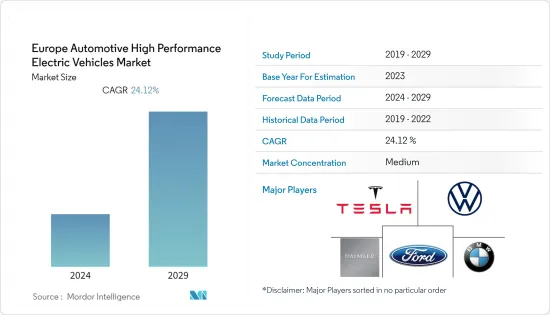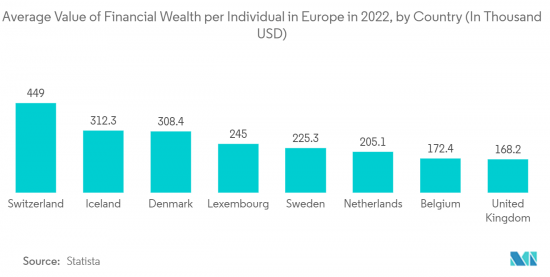PUBLISHER: Mordor Intelligence | PRODUCT CODE: 1404358

PUBLISHER: Mordor Intelligence | PRODUCT CODE: 1404358
Europe Automotive High Performance Electric Vehicles - Market Share Analysis, Industry Trends & Statistics, Growth Forecasts 2024 - 2029

The European automotive high-performance electric vehicles market is valued at USD 160.14 billion in the current year. It is anticipated to reach USD 582.14 billion over the next five years, registering a CAGR of about 24.12% during the forecast period.
Over the long term, growing awareness of vehicle emissions, lower operating and maintenance costs, along increasing government initiatives to encourage the use of electric vehicles will drive the growth of high-performance electric vehicles. The growing demand for these types of vehicles is primarily due to the increasing popularity of racing events in Europe. An electric high-performance vehicle (EHPV) is propelled by electricity and is equipped with advanced electric vehicle powertrain components and Li-ion batteries with high energy density.
Europe set ambitious emission reduction targets to combat climate change. Tighter regulations, especially in urban areas, are aimed at reducing pollution and encouraging the introduction of electric vehicles (EVs). These regulations, such as low emission zones and stringent emission standards, are encouraging fleet managers to switch to electric commercial vehicles.
Governments across Europe offer various incentives to encourage the uptake of electric vehicles. These incentives include purchase subsidies, tax incentives, and subsidies for building charging infrastructure. It helps offset the high acquisition costs of electric vans, making them more economically attractive to fleet operators.
According to the ACEA, the new light commercial vehicle registrations in the EU fell by 14.4%, totaling 102,226 units as of October 2022. All the major EU markets posted declines last month, especially Germany (-16.6%), Italy (-7.3%), and France (-6.7%), while new van sales remained relatively stable in Spain (-0.5%).
Furthermore, in Europe, Germany includes an increasing number of electric car sales in the region, as well as an increase in charging stations, which will also play an important part in boosting the sale of High-Performance electric vehicles. In 2021, there were around 59,400 publicly accessible charge points for electric vehicles in Germany. Furthermore, technological progress and new developments in the high-performance electric car market may help the market's growth in Germany.
Europe Automotive High Performance Electric Vehicles Market Trends
Increasing Demand of Luxury Vehicles is Expected to Drive the Market
Currently, the IC engine segment leads the high-performing luxury car market. However, during the forecast period, the demand for IC engine vehicles is anticipated to slow down as major players in the European region are planning to completely stop the production of gasoline cars and focus on manufacturing electric cars only. For instance,
- In September 2023, Volvo Cars announced the end of production of all its diesel-powered models by early 2024. The company plans to sell only fully electric cars by 2030 and to be a climate-neutral company by 2040. Recently, the company also announced to exit of the development of new combustion engines.
It can be attributed to growing environmental concerns due to rising exhaust emissions. Governments in Europe and environmental associations are tightening emission norms. A 45% reduction in CO2 emissions by 2030 requires more than 400,000 zero-emission vehicles on the road. Therefore, various government initiatives and regulations will also boost the growth of high-performance electric luxury vehicles in the market.
As a result, the demand for sustainable and eco-friendly transportation, such as EVs, is increasing, with governments offering more incentives and subsidies to these vehicle owners.
Currently, major players, such as Mercedes-Benz, BMW, Audi, and Tesla, cover a significant percentage of the share in the EV segment of the luxury car market. Additionally, luxury car component manufacturers are also focusing on developing next-generation smart mobility technologies, such as autonomous driving, personal voice assistance, and retinal recognition. These are expected to boost the sales of luxury EVs over the forecast period.
Further, the growing number of HNWI in the European region is also expected to contribute to the growth of the electric luxury vehicle market. In Europe, the overall average financial wealth per adult as of 2022 was USD 84,308. In terms of private wealth, Europe held the second highest value in the world after North America.
Hence, the factors above are expected to contribute to the growth of the market during the forecast period.

Germany is Leading the Market
Germany is leading the electric vehicle market in the region as, according to the Federal Motor Transport Authority, a quarter more electric cars were registered in Germany in the first half of 2022 than the previous year over the same period. During that time, the proportion of fully electric vehicles climbed to 13.5% of all new registrations. Overall, alternative-drive car registrations climbed by 14.2%, accounting for over half of all new car registrations (battery electric vehicles, hybrids, plug-in hybrids, hydrogen fuel cell vehicles, and gas vehicles). German brands accounted for 50.6% of new passenger car registrations with electric powertrains during the reporting period.
By 2030, Germany hopes to include 15 million electric vehicles on the road. Furthermore, the German Federal Government is aggressively supporting the usage of plug-in electric vehicles. Furthermore, since the rise in BEV subsidies in June 2020, the market share of BEVs steadily increased. Aside from the environmental benefits, the increasing availability of electric vehicles on the market is driving growth.
However, there is evidence of the country's growing popularity of electric automobiles. As a result, the German government is anticipated to eliminate financial incentives for acquiring electric vehicles next year, as rising popularity renders government subsidies outdated. E-vehicles are getting more popular and will soon no longer require government subsidies. According to the plan, subsidies for solely electric vehicles priced under EUR 40,000 (USD 40,488) will be cut to EUR 4,500 (USD 4794.82) from EUR 6,000 (USD 6393.09) at the beginning of next year and to EUR 3,000 (USD 3196.55) by 2023. According to government sources, the incentives granted to electric car owners will expire once the next two years' budget of EUR 3.4 billion (USD 3.44 billion) is expended.
Moreover, the government in Germany also took a few steps to grow EVs in the country. For instance,
- In October 2022, as part of its push toward net zero emissions, the German government approved a plan to spend EUR 6.3 billion (USD 6.1 billion) over three years to rapidly expand the number of charging stations for electric vehicles across the country. The plan calls for a 14-fold increase in the number of charging stations, from currently around 70,000 to 1 million by 2030.
Thus, growing charging infrastructure across Europe is expected to drive the automotive high-performance vehicle in the market.
Europe Automotive High Performance Electric Vehicles Industry Overview
The European automotive high-performance electric vehicles market is moderately consolidated and highly competitive with the presence of players such as BMW Group, Daimler AG, and Volkswagen AG, amongst others. Companies are launching new models and investing in R&D projects to provide the best technology to electric vehicle customers. Along with that, governments are also actively reforming their laws to increase the adoption of electric vehicles. For instance,
- In June 2023, as part of the Escalate Project, Electra Commercial Vehicles received funding from the European Horizon 2022 framework to develop a long-haul 40-tonne temperature-controlled drawbar battery electric vehicle. The truck will be built on an Electras eStar LEM27-350 chassis, with a drawbar trailer that includes energy-efficient electrically powered refrigerated systems, high-performance insulated box bodies with tail lifts, and the latest technology in lightweight, low-profile solar panels to help maximize range.
- In September 2022, Mercedes-Benz Trucks stated that real-world testing of its battery-electric heavy-duty long-distance vehicle will begin soon. Amazon and Rhenus plan to put the eActros LongHaul through its paces as early as 2023. Mercedes-Benz Trucks signed a letter of intent with both firms. The series will begin production in 2024.
Hence, the developments above are expected to drive the automotive high-performance electric vehicle market.
Additional Benefits:
- The market estimate (ME) sheet in Excel format
- 3 months of analyst support
TABLE OF CONTENTS
1 INTRODUCTION
- 1.1 Study Assumptions
- 1.2 Scope of the Study
2 RESEARCH METHODOLOGY
3 EXECUTIVE SUMMARY
4 MARKET DYNAMICS
- 4.1 Market Drivers
- 4.1.1 Increasing Demand of Luxury Vehicles is Expected to Drive the Market
- 4.2 Market Restraints
- 4.2.1 High Cost of the Vehicle may Hinder the Market Growth
- 4.3 Industry Attractiveness - Porter's Five Forces Analysis
- 4.3.1 Bargaining Power of Suppliers
- 4.3.2 Bargaining Power of Buyers/Consumers
- 4.3.3 Threat of New Entrants
- 4.3.4 Threat of Substitute Products
- 4.3.5 Intensity of Competitive Rivalry
5 MARKET SEGMENTATION (Market Size in USD)
- 5.1 By Drive Type
- 5.1.1 Plug-in Hybrid
- 5.1.2 Battery or Pure Electric
- 5.2 By Vehicle Type
- 5.2.1 Passenger Cars
- 5.2.2 Commercial Vehicles
- 5.3 By Country
- 5.3.1 Germany
- 5.3.2 United Kingdom
- 5.3.3 Italy
- 5.3.4 France
- 5.3.5 Spain
- 5.3.6 Rest of Europe
6 COMPETITIVE LANDSCAPE
- 6.1 Vendor Market Share
- 6.2 Company Profiles
- 6.2.1 Telsa Inc.
- 6.2.2 Volkswagen AG
- 6.2.3 Daimler AG
- 6.2.4 Ford Motor Company
- 6.2.5 BMW Group
- 6.2.6 Rimac Automobili
- 6.2.7 Renault
- 6.2.8 Kia Motor Corporation
- 6.2.9 Mitsubishi Motors Corporation
- 6.2.10 Peugeot
- 6.2.11 Nissan Motor Company Ltd
7 MARKET OPPORTUNITIES AND FUTURE TRENDS




